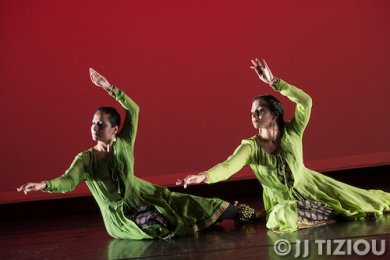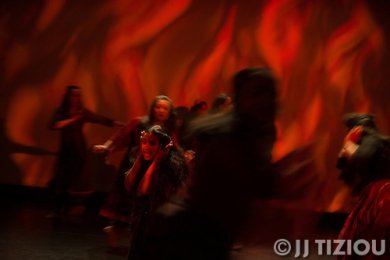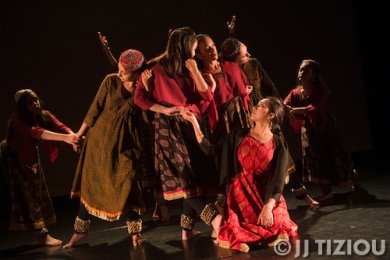
|   |

|   |
Weaving what’s torn: Asunder by the Courtyard Dancers - Mytili Jagannathan e-mail: mytili@itinerantink.com August 6, 2014 At a nearly full house performance of new dance-theater on June 28 at the Painted Bride Art Center in Philadelphia, the Courtyard Dancers, led by dance anthropologist and Kathak choreographer/dancer Pallabi Chakravorty, created a tense and intensely relational somatic landscape of form, event, and feeling. The Courtyard Dancers are known for their activation of the syncretic, feminist, and populist energies of Kathak, a sensibility which was especially resonant for the subject of this performance. The hour-long program was organized in three parts: an opening dance piece, a musical interlude, and finally, the centerpiece of the evening: Asunder, a meditation on - and under the shadow of - the Partition.  The first piece, Weavers, set to the popular ghazal “Aaj jaane ki zid na karo,” foregrounded the binding power of form: the visual ensemble composition and rhythmic patterns of traditional Kathak. It opened with a tabla solo, spot-lit on the left side of an otherwise darkened stage, and then slowly, like an advancing sunrise, light and dancers filled the stage: first six, then two more. Layered onto the rhythmic core of vocalized syllables and percussive footwork was choreography that evoked scenes of women’s friendship and companionable labor, with sequences of dancers coming together, clasping hands and then releasing into gentle spins and gestures of beckoning to an absent interlocutor, or to an implied horizon. Visually, the dancers’ costume palette was soft green and pink/purple, creating a subtly dynamic but broadly unifying look, especially when the spins showed off the airy full skirts to maximum effect. At moments, a locked gaze between two of the dancers at a distance from each other across the stage heightened the sense of connectivity, activating a warm line of diagonal energy. After the painterly visuals of Weavers, the live musical interlude was an intricate offering to the ear, showing off the talents of Aqeel Bhatti on tabla, and Joel Rehmat on harmonium and vocals. In flowing musical conversation, they unfurled “Lambi Judai” (made famous by Reshma, the late folk singer born in 1947 in current day Rajasthan, who migrated with her tribe to Pakistan after the Partition, and whose music was beloved on both sides of the border), and then a ghazal by Faiz Ahmed Faiz, transporting listeners and drawing appreciative murmurs of recognition. Within the arc of the evening, the music could be understood as both timeless, and as a kind of before-the-fall moment of oneness, a contrast for the dark turn of the final piece. 

Gathering momentum from the fuel of form as well as the evocative choice of Baul and Thumri songs (both of which are rooted in syncretic/mystical spirituality), in the featured piece, Asunder, dance reconfigured itself as event and feeling. Avoiding explicit narrative about the Partition in its choreography and even in the written program, the dance seemed to address itself to an audience that knows, in some sense, the story. A flash on a dark stage illuminated a single dancer with her back to the audience; and behind her on a screen, a tree-shadow scene. Arms rose and fell, reached out and in; strength collapsed and was reconstituted. The dance was peppered with entrances and exits, telegraphing a sense of turmoil and anxious transiency; figures, wounded or hiding, hugged the floor, covering their ears; images of fire lit up the screen behind. Gradually, the dancers split into opposing forces; their costumes acquired distinctions to mark Hindu and Muslim; the rhythm took a decidedly martial turn. Pairs or groups of dancers encountered and circled each other, with an exquisitely held tension that suggested a prior kinship, now irrevocably torn; under this new shadow, those who were outnumbered in an unlucky instance must fall or burn. And fight sparked flight: while the dancers moved across the stage, archival photos on the screen depicted a long line of people walking—that frozen movement a haunting sliver of Partition’s massive migration of human beings, all trying to reach the place where they are told “their kind” will be safe. Arriving at this history-shaping rupture, the Courtyard Dancers reminded us that forms have their own particular doors to knowing and feeling. This past-meets-present Kathak, cognizant of the dance form’s own complex Muslim and Hindu layering, transmitted a lingering, multi-voiced, embodied sense of an event that stopped one kind of time, and started another. Mytili Jagannathan is a poet and writer based in Philadelphia, where she also works as an educator and as a consultant to the nonprofit sector. She is the author of a chapbook, Acts, and her poems have appeared in a range of venues, including Indivisible: An Anthology of Contemporary South Asian American Poetry. Her writing has been recognized by a grant from the Leeway Foundation and a Pew Fellowship in the Arts. |